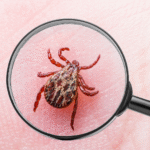
Don't let Tick-Bites ruin your summer
Whether you’re hiking, gardening, or simply enjoying time outdoors, protecting yourself from Lyme disease starts with being prepared. Our free Tick-Bite Ready Guide gives you the tools to feel confident, informed, and protected.
Why Preventing Lyme Disease Matters
Lyme disease is a serious tick-borne illness that, if left untreated, can cause long-term complications including chronic joint pain, nervous system issues, heart conditions, and memory or mood problems. Early detection and prevention are key to avoiding these serious health outcomes.
What’s Inside the Tick-Bite Ready Guide
- How to Identify a Tick Bite
- Lyme Disease: What Is It and Why It Matters
- How to Prevent a Tick Bite
- How to Recognize a Lyme Rash
- Early Signs of Lyme Disease
- S.O.S. I’ve Been Bitten – What to Do Next
- How to Safely Remove and Test a Tick
- How to Treat to Prevent Lyme Disease
- When (and When Not) to Treat
- Understanding Lyme Disease Testing in Canada
Why You’ll Want This Guide
Knowledge is power—especially when it comes to your health. Ticks are active from spring through fall, and Lyme disease cases are rising across Canada. This free guide helps you act quickly, prevent infection, and know exactly what to do if a tick bites you or your child.
Are Lyme Disease Rashes Itchy?
Most Lyme disease rashes, particularly the classic “bull’s-eye” rash known as erythema migrans, are not itchy or painful. They tend to feel warm to the touch and expand over time. If your rash is itchy, it may be caused by another condition or skin reaction and should still be checked by a healthcare provider.
How Does Lyme Disease Spread?
Lyme disease spreads through the bite of an infected black-legged tick (often called a deer tick). It is not spread person-to-person, and you cannot get it from food, water, or casual contact.
Can Lyme Disease Kill You?
Not typically. Instead, untreated Lyme can lead to serious complications that affect the heart (Lyme carditis), nervous system, or brain. Early diagnosis and treatment significantly reduce the risk of long-term effects and serious health outcomes.
Why Is Lyme Disease on the Rise?
Lyme disease is on the rise due to several factors, including climate change, rising deer populations, and expanding tick habitats. In the Yukon, where Dr. Alton practices, only in the last 8-10 years have rural deers started to take up habitat in the territory, coming up from Northern B.C. Warmer, longer seasons are allowing ticks to survive and spread into new areas, including parts of Canada that previously had low or no risk.
Download the Free Guide Now
Join the email list to get more guides and integrative medicine health tips, and download the free Tick-Bite Ready guide.

